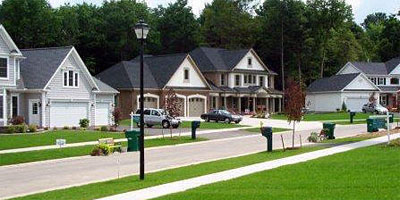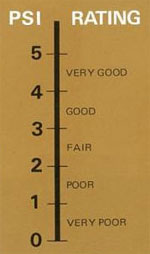Benefits of Concrete Streets
A Close Look at a Good Buy
Benefits | Economic | Curb Appeal | Fast Placement | Concrete Streets | Walmart Parking Lots

 The true value of any pavement, whether a multiple-lane expressway, primary highway, secondary road, or city street, is determined by assessing a number of factors. For city streets the most important are:
The true value of any pavement, whether a multiple-lane expressway, primary highway, secondary road, or city street, is determined by assessing a number of factors. For city streets the most important are:
Annual cost
Load capacity
Safety
Performance
Appearance
How would you rate the streets in your community?
Annual pavement cost can be defined as the average yearly expenditure necessary to build and maintain a pavement in good repair over its useful life. The following factors determine annual costs.
First Cost
The quality paving material, concrete, is often thought to be much higher in first cost than asphalt. Actually for concrete and asphalt pavements that have reasonably comparable initial load-carrying abilities, the first cost difference, if any, is small. Larger differences occur only when a durable concrete pavement is compared with an inadequate asphalt pavement.
Why are cities increasing their minimum standards for streets? Inadequate performance and excessive maintenance are the reasons.
Expanding communities need money to build more streets and other utilities in order to attract new industry and responsible citizens. It is impossible to build these new streets when current operating budgets are being devoured by maintenance requests for sealing, patching, and resurfacing. Studies show a four-to-one and a seven-to-one cost advantage for concrete in reduced pavement maintenance.

Fig. 1. *Cities use various methods of recordkeeping. For ease of comparison, they appear here as a ratio with concrete taken as 1.
Many communities whose street maintenance budgets have been depleted by continual repair of substandard streets have now recognized the necessity for building high-quality streets. Realizing that their streets should be constructed to last as long as the adjacent homes, communities now insist on only concrete for new subdivision streets. The cost of these streets is most often borne by the developer and passed on to the home or condominium buyer with the cities or counties assuming all necessary future maintenance paid for by taxes on all property owners. Insisting on high-quality concrete ensures adequate streets for years to come.
Is your city having budget trouble trying to keep up with requests to patch worn-out streets?
A planned program of concrete street construction offers an eventual solution.
How does the life expectancy of a concrete pavement compare with that of asphalt pavement?

A Federal Highway Administration report ("Service Lives of Highway Pavements," Public Roads, August 1971) gives the average surface life of concrete roads as 25 years and asphalt as 15 years. This is better than a 50% longer life for concrete highways compared with high-type asphalt highways of supposedly equal load-carrying capacities. For city pavements, the vast number of 30‑to 50-year-old concrete streets readily attests to their performance beyond the study figure of 25 years, while most asphalt streets would be hard pressed to last for 15 years.
Are your asphalt streets giving you 15 years of uninterrupted performance?
True Pavement Cost
In determining the true cost, the first cost must be spread over the pavement's useful service life. For concrete this may be anywhere from 30 to 50 years.
To this must be added the annual maintenance costs. It costs four to seven times as much to maintain an asphalt pavement.

Concrete pavements can be designed to serve adequately every class of street from a heavily traveled arterial or industrial to a lightly traveled residential.
A comprehensive and highly successful study of pavement performance was conducted by the American Association of State Highway and Transportation Officials at the AASHO Road Test near Ottawa, Illinois, in 1955-60. The test established firm relationships between repetitions of loads and pavement performance.
Performance of a pavement is a measure of how well and how long it serves traffic. It is measured in terms of a serviceability index. At the AASHO Road Test a rating team assigned ratings of 0, very poor, to 5, very good (Fig. 3 below). When a pavement's serviceability index dropped to 1.5 it was considered failed and taken out of test. In the charts that follow (Figs. 4, 5, and 6), the serviceability index at the end of the test (1.1 million load repetitions) are shown. Or if the pavement failed, the number (in 1,000's) of load repetitions to failure.
Of special significance to municipal engineers and officials are the data relating to the lighter pavement designs. Typical examples of the high serviceability delivered by concrete sections are shown on the charts. The thinnest concrete design in more than one test was 3½-in. concrete with no subbase. Not only did this thin design show a final serviceability of "good" under 6,000-lb loads, but it also withstood more than 100,000 loads of 12,000 lb. (See Fig. 4 and Fig. 5.)
Fig. 3. Serviceability index & rating

When pavement thickness was increased to 5 in. with no subbase, a "very good" rating was maintained for the entire test period for the 6,000-lb loads (see Fig. 4). On another similar 5-in. section more than a quarter million 18,000-lb loads were carried (see Fig. 6).
The 6½-in. concrete pavement with no subbase sustained 12,000-lb loads for the full 1,114,000 load applications of the test. Final serviceability again was "good" (see Fig. 5). Even under deliberate overloading of a 22,400-lb single-axle load, the 6½-in. concrete on no subbase went out of test only after more than 300,000 load applications (not shown). These data show that concrete pavement designed for street traffic can withstand the usual overloads without distress—offering conclusive evidence to support the choice of concrete for city streets.
In addition to providing for structural design analysis, concrete streets are immune to spring breakups so common to asphalt streets. The beam strength inherent in every slab of concrete distributes traffic loads over wide areas of the subgrade and thus permits passage of heavy loads without disruption of the underlying subgrade.
With traffic accidents claiming many lives each year, safety is a vital element in planning and building city streets. Highway engineers, safety officials, and the motoring public are all looking for every possible means of reducing this toll. Safety authorities have long agreed that there are three essential elements in any traffic safety program—education, enforcement, and engineering. While engineering can't build an accident-proof highway, it can provide greater safety through the use of concrete pavements. Concrete's gritty texture maintains its skid-resistant properties throughout its life—wet or dry.
Night driving is always hazardous, but on city streets it is particularly so because of many pedestrians, bicyclists, and parked cars. It is most desirable for a residential street to have high light reflectivity. The added safety factor of concrete's extra visibility is hard to measure, but if it contributes to the saving of even one life, it would be of immense value. In addition to promoting greater driving safety, bright, well-lighted streets are a deterrent to crime, as law officials have frequently observed.
Performance
The streets shown here are typical of the long years of service provided by concrete. They have served their communities well with little maintenance—proof of the economy of concrete streets.
Appearance
Concrete streets are attractive because of their clean, even surface. Concrete streets stay that way too. They wash clean with every rain. There is no gummy surface to bind dirt and debris to the pavement, no loose sand or stones to mar the finish of your automobile. The clean appearance of concrete lasts for the life of the pavements and continues to be a source of pride and satisfaction to the city fathers who specified them, the contractors who built them, and the property owners who live by them.
Neat, well-lit neighborhoods attract good neighbors and build community spirit. A street is like a home; it is an investment that should last a lifetime. A home well-built of good materials requires little maintenance. Streets should be the same—substantially built of quality materials with little upkeep needed.
Have your streets produced a value to you and your community commensurate with their cost? They have if they are concrete. This close look shows taxpayers benefit in these ways:
Lowest annual cost
Adequate design
Built-in safety features
Superior performance
Attractive appearance
Concrete streets are the best investment for your community.


